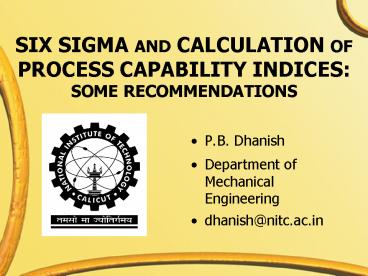SIX SIGMA AND CALCULATION OF PROCESS CAPABILITY INDICES: SOME RECOMMENDATIONS - PowerPoint PPT Presentation
1 / 34
Title:
SIX SIGMA AND CALCULATION OF PROCESS CAPABILITY INDICES: SOME RECOMMENDATIONS
Description:
SIX SIGMA AND CALCULATION OF PROCESS CAPABILITY INDICES: SOME RECOMMENDATIONS P.B. Dhanish Department of Mechanical Engineering dhanish_at_nitc.ac.in – PowerPoint PPT presentation
Number of Views:548
Avg rating:3.0/5.0
Title: SIX SIGMA AND CALCULATION OF PROCESS CAPABILITY INDICES: SOME RECOMMENDATIONS
1
SIX SIGMA AND CALCULATION OF PROCESS CAPABILITY
INDICES SOME RECOMMENDATIONS
- P.B. Dhanish
- Department of Mechanical Engineering
- dhanish_at_nitc.ac.in
2
Overview
- What is Six Sigma?
- The sample size problem
- The distribution problem
- The control problem
- Conclusion
3
What is Six Sigma?
- Disciplined quality improvement
- AIM Near elimination of defects
- NUMERICALLY 3.4 DPMO!
4
Defect levels at various sigmas
5
What is sigma?
- Statistics
- The process standard deviation
Then, six sigma?
- Specification limits should be at
- /- six sigma
6
Then, how many defects?
- Assuming
- Normal distribution
- The area under the normal curve beyond /-six
sigma - Fraction non-conforming
- Multiply by 1,000,000 to get DPMO
- If the process is centred on target, 0.002 DPMO
7
(No Transcript)
8
Such perfect centering
- Not possible in practice
- Allow /-1.5 sigma shift
- Then the defect level will be 3.4DPMO
9
(No Transcript)
10
The sample size problem
- In practice, true sigma is unknowable
- Sample standard deviation
- From a finite number of samples
- Sampling error in sigma level
- Single value not meaningful
- Hence Give Confidence Limits
11
If x is normally distributed
- an upper 100(1-a) confidence limit for s is
- and an upper 100(1- a) confidence limit for µ is
12
Assuming that mean and sigma are independent
- to calculate an upper 100(1-a) confidence limit
for the proportion nonconforming p, - construct 100(1-a)1/2 confidence limits for
each parameter separately - using these two values, determine p
13
For example,
- If n25, USL6, LSL-6, 0, and s1,
- a 97.47 upper confidence limit for s is
- and a 97.47 upper confidence limit for µ is
14
Then the proportion nonconforming
- 30.967ppm
15
Alternative Determine sample size for the
required confidence level
16
Recommendation 1
- Do NOT give a single value for the sigma level of
your process - Instead,
- Give confidence limits
- OR
- the confidence level
17
The distribution problem
- Above calculations utilise
- the tail end of the normal distribution
- Does any process in nature match the values in
the tail?
18
The values in the tail
19
To check the correctness,
- We need millions of samples!
- No shift in the process during this production!
- Hence impossible to verify
- the exact values of the defect levels, say 3.4 or
5 DPMO, may not have practical significance
20
Not normally distributed
- Surface Finish
- Circularity
- Runout
- Hence, take care
21
Cramer (1945) Lippman
- everybody believes in the law of errors,
- the experimenters because they think it is a
mathematical theorem, - the mathematicians because they think it is an
experimental fact
22
Recommendation 2
- Verify that the distribution is normal
- Otherwise, utilise the appropriate distribution
- Realise that the exact values of low defect
levels are meaningless
23
The Control Problem
- To claim that future performance would be
similar, - the process should be stable
- OR
- in statistical control
24
Deming (1986)
- One sees much wrong practice in connection with
capability of the process. It is totally wrong to
take any number of pieces such as 8, 20, 50 or
100, measure them with calipers or other
instruments, and take 6 standard deviations of
these measurements as the capability of the
process
25
Consider thirty observations
- -1.6, -1.2, -1.9, -0.6, -1.6, -1.4,
- -0.5, -0.9, -0.2, -0.7, 0.2, -0.5,
- 0.3, -0.4, 0.5, -0.3, 0.4, -0.2,
- 0.8, 0.6, 0, 1.2, 2, 0.5,
- 0.9, 0.8, 0.1, 1.4, 0.6, 1.7
- Mean 0
- Standard deviation 1
26
Histogram
27
An excellent process?
- If specification limits are /-3
- Wait,
- Just plot a run chart for the given measurements
28
The process is drifting!
29
No capability can be ascribed!
- QS9000 Distinguishes between Cpk and Ppk
- An undisturbed process Shouldnt it be in
control? - Very very unlikely
- An SPC program necessary
30
Nelson (2001)
- Getting a process in statistical control is not
improvement (though it may be thought of as
improvement of the operation), getting a process
in statistical control only reveals the process,
and after a process is in statistical control,
improving it can begin.
31
Another pitfall
- Samples taken too infrequently
- This way, any process can be made to appear in
control! - A common cause for failure of SPC
32
Recommendation 3
- Ensure that the process is stable or in
statistical control
33
Any questions?
34
Conclusion
- Industries while claiming Six Sigma, should
- 1. reveal the confidence level of their sigma
calculation - 2. The process distribution utilised
- 3. How process stability was verified































